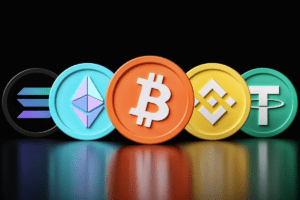Introduction to Solana
In the world of cryptocurrencies and blockchain technology, Solana has emerged as a promising platform that aims to revolutionize the industry. To understand Solana’s significance, it’s essential to grasp the basics of cryptocurrencies and blockchain technology, as well as the specific role Solana plays in the crypto space.
Understanding Cryptocurrencies and Blockchain Technology
Cryptocurrencies are digital or virtual currencies that utilize cryptography for secure financial transactions. Unlike traditional currencies issued by central banks, cryptocurrencies are decentralized and operate on a technology called blockchain.
Blockchain technology is a distributed ledger that records and verifies transactions across multiple computers or nodes. It provides transparency, security, and immutability to the data stored within the blockchain. Each transaction is added to a block, which is then linked to the previous blocks, forming a chain of information.
Overview of Solana’s Role in the Crypto Space
Solana is a high-performance blockchain platform designed to address the scalability and transaction speed limitations that have hindered many existing cryptocurrencies. It aims to provide a decentralized infrastructure that can handle a large volume of transactions at lightning-fast speeds.
Solana’s architecture incorporates several innovative features, including the Proof of History (PoH) mechanism, the Tower BFT consensus algorithm, and the Gulf Stream architecture. These elements work together to enhance the platform’s performance, scalability, and security, making it an attractive option for developers and users alike.
By leveraging these advancements, Solana aims to enable decentralized applications (dApps) with real-world use cases, such as decentralized finance (DeFi), non-fungible tokens (NFTs), and more. The platform’s focus on scalability, low transaction costs, and a developer-friendly ecosystem sets it apart from other blockchain solutions.
To learn more about Solana’s technical aspects and tokenomics, you can refer to the Solana whitepaper. Additionally, exploring the platform’s scalability solutions, ecosystem, and partnerships can provide deeper insights into Solana’s potential and future developments. You can find more information on these topics in our related articles on Solana scalability, Solana ecosystem, and Solana partnerships.
As we delve further into Solana’s whitepaper, we will uncover key concepts and understand how they contribute to Solana’s success in the crypto space.
The Solana Whitepaper
In the world of cryptocurrencies, whitepapers play a significant role in introducing new projects and outlining their underlying technology. The Solana project is no exception, as it also has a whitepaper that provides crucial insights into its goals, technology, and potential impact on the crypto space.
Importance of the Whitepaper in the Cryptocurrency World
Whitepapers serve as a foundational document for cryptocurrencies and blockchain projects. They provide detailed explanations of the project’s objectives, technical architecture, consensus mechanisms, and other key aspects. Whitepapers allow developers, investors, and enthusiasts to gain a comprehensive understanding of the project and its potential.
For Solana, the whitepaper serves as a key resource for individuals interested in learning about the project’s innovative approach to scalability, performance, and decentralization. It helps stakeholders assess the project’s legitimacy, technical viability, and potential for future growth.
Overview of the Solana Whitepaper
The Solana whitepaper outlines Solana’s unique approach to addressing the key challenges faced by many blockchain platforms, such as scalability and throughput limitations. It introduces innovative concepts and technologies that aim to improve the overall efficiency and speed of blockchain transactions.
The whitepaper focuses on three main concepts:
-
Proof of History (PoH): Solana’s PoH is a cryptographic technique that provides a historical record of all events in the network. By leveraging a verifiable delay function, PoH establishes a trustless and tamper-proof ordering of transactions, enabling efficient consensus and reducing the time required for confirming transactions.
-
Tower BFT Consensus Algorithm: Solana utilizes a variation of the Practical Byzantine Fault Tolerance (PBFT) consensus algorithm called Tower BFT. This consensus algorithm allows for fast finality, where blocks are confirmed quickly and transactions are settled securely.
-
Gulf Stream Architecture: Solana’s Gulf Stream Architecture combines several innovative components, such as a high-performance transaction processing engine, parallel transaction processing, mempool-less transaction forwarding, and a low-level programming language called BPF. This architecture enables Solana to achieve high scalability and throughput, making it capable of handling thousands of transactions per second.
By presenting these key concepts, the Solana whitepaper provides a clear roadmap for the project’s technical implementation and its potential impact on the future of blockchain technology.
To delve deeper into specific aspects of Solana’s technology, such as its tokenomics, scalability, and ecosystem, consider exploring our articles on Solana tokenomics, Solana scalability, and Solana ecosystem.
Key Concepts in the Solana Whitepaper
The Solana whitepaper introduces several key concepts that are crucial to understanding the technology and innovation behind Solana. These concepts include Proof of History (PoH), the Tower BFT Consensus Algorithm, and the Gulf Stream Architecture.
Proof of History (PoH)
Proof of History (PoH) is a fundamental concept introduced in the Solana whitepaper. It is a cryptographic tool designed to create a historical record of events in a decentralized network. PoH provides a reliable and verifiable sequence of events, allowing the Solana network to achieve high scalability and performance.
By incorporating a decentralized clock into the blockchain, Solana leverages PoH to order and timestamp transactions. This approach eliminates the need for traditional consensus algorithms to synchronize time across nodes, reducing network latency and enabling faster transaction processing.
Tower BFT Consensus Algorithm
The Tower Byzantine Fault Tolerance (BFT) Consensus Algorithm is another key concept outlined in the Solana whitepaper. Tower BFT is a unique and innovative consensus algorithm designed to achieve fast finality and high throughput.
In the Tower BFT consensus algorithm, a dynamic set of verifiers, known as validators, participate in the consensus process. These validators are responsible for confirming the validity of transactions and maintaining the integrity of the Solana blockchain. Through a process of voting and signature collection, the Tower BFT algorithm ensures the agreement and finality of transactions in a highly efficient manner.
Gulf Stream Architecture
The Gulf Stream Architecture is an architectural design introduced by Solana to achieve scalability and optimize transaction processing. It is built on a combination of several techniques, including Proof of History, Tower BFT, and a unique mechanism known as Turbine.
The Gulf Stream Architecture enables Solana to process thousands of transactions per second, making it one of the most scalable blockchain platforms available. By leveraging parallel processing and data sharding, Solana achieves high throughput without compromising security or decentralization.
Understanding these key concepts presented in the Solana whitepaper is essential to grasp the innovative approach and potential of Solana’s technology. By combining Proof of History, the Tower BFT Consensus Algorithm, and the Gulf Stream Architecture, Solana aims to revolutionize the scalability and performance of blockchain networks. To learn more about Solana’s tokenomics, scalability, and ecosystem, visit our articles on Solana tokenomics, Solana scalability, and Solana ecosystem, respectively.
Advantages of Solana
Solana, as a cryptocurrency and blockchain platform, offers several advantages that set it apart in the crypto space. These advantages include scalability and performance, low transaction costs, and a developer-friendly ecosystem.
Scalability and Performance
One of the key advantages of Solana is its exceptional scalability and performance. The Solana blockchain is designed to handle a high volume of transactions without sacrificing speed or efficiency. By utilizing a unique combination of innovative technologies, such as Proof of History (PoH) and the Tower BFT consensus algorithm, Solana can achieve high throughput and fast confirmation times.
To put it into perspective, Solana’s network can currently handle over 65,000 transactions per second (TPS), making it one of the fastest blockchain networks available. This scalability enables Solana to support a wide range of decentralized applications (dApps) and handle the demands of large-scale projects. For more information on Solana’s scalability, check out our article on Solana scalability.
Low Transaction Costs
In addition to its scalability, Solana offers low transaction costs, making it an attractive option for users and developers. The efficiency of Solana’s blockchain architecture allows for cost-effective transactions, reducing the fees associated with sending and receiving Solana tokens. This affordability makes Solana an appealing choice for various use cases, including microtransactions and decentralized finance (DeFi) applications.
By minimizing transaction costs, Solana aims to create a more inclusive and accessible financial ecosystem. Whether you’re a user looking to transfer funds or a developer building applications on the Solana blockchain, the low transaction costs contribute to a more efficient and cost-effective experience. To learn more about Solana’s tokenomics and the benefits it offers, visit our article on Solana tokenomics.
Developer-Friendly Ecosystem
Solana provides a developer-friendly ecosystem that fosters innovation and enables the creation of decentralized applications. With its robust set of developer tools, Solana simplifies the process of building on the blockchain. The Solana ecosystem offers comprehensive documentation, software development kits (SDKs), and other resources to support developers in creating and deploying their projects.
The Solana ecosystem also encourages collaboration and partnerships, allowing developers to leverage the expertise of others and explore new possibilities. Through initiatives like hackathons and grants programs, Solana actively supports the growth of its developer community. To learn more about the Solana ecosystem and the opportunities it offers, check out our article on Solana ecosystem.
By combining scalability, low transaction costs, and a developer-friendly ecosystem, Solana positions itself as an innovative blockchain platform. As Solana continues to evolve and gain traction in the crypto space, it has the potential to shape the future of cryptocurrencies and blockchain technology. However, it’s important to consider the challenges and opportunities that lie ahead. To explore the potential impact of Solana and the road ahead, continue reading our article on Solana roadmap.
Implications for the Future of Cryptocurrencies
As Solana continues to make waves in the cryptocurrency world, its innovative technology and unique approach have the potential to make a significant impact on the future of blockchain technology.
Potential Impact on Blockchain Technology
Solana’s advancements in scalability, speed, and performance could potentially address some of the key limitations faced by existing blockchain networks. By introducing concepts like Proof of History (PoH), the Tower BFT consensus algorithm, and the Gulf Stream architecture, Solana aims to create a highly scalable and efficient blockchain ecosystem.
Scalability has long been a challenge for many blockchain networks, with issues like slow transaction speeds and high fees hindering widespread adoption. Solana’s ability to process thousands of transactions per second, as demonstrated by its mainnet, has the potential to revolutionize the industry. The use of the Tower BFT consensus algorithm allows for quick and secure confirmation of transactions, further enhancing the speed and efficiency of the Solana network. For a more detailed understanding of Solana’s scalability, refer to our article on Solana scalability.
Furthermore, Solana’s low transaction costs could pave the way for broader economic inclusion and accessibility. The efficient utilization of network resources and the elimination of high fees may make it more feasible for individuals and businesses to participate in the blockchain ecosystem. By reducing barriers to entry, Solana has the potential to democratize access to cryptocurrencies and blockchain technology.
Opportunities and Challenges Ahead
As Solana continues to gain traction, it presents various opportunities and challenges for the future of cryptocurrencies. Some potential opportunities include:
-
Expanded Use Cases: Solana’s high throughput and low transaction costs create opportunities for new and existing applications to thrive on the blockchain. This could lead to the development of innovative decentralized applications (dApps) and the integration of blockchain technology into various sectors such as finance, gaming, supply chain, and more.
-
Ecosystem Growth: Solana’s developer-friendly ecosystem, with its robust tooling and documentation, may attract developers to build on the platform. This could foster a vibrant and diverse ecosystem of applications and services, further driving the adoption and growth of Solana.
-
Partnerships and Collaborations: Solana’s impressive technology and potential may attract strategic partnerships and collaborations with other blockchain projects, enterprises, and institutions. These partnerships could lead to the integration of Solana’s technology into existing systems and the exploration of new possibilities.
However, along with these opportunities, Solana also faces challenges that need to be addressed for sustained growth. These challenges include:
-
Competition: The blockchain space is highly competitive, with numerous projects vying for market share and adoption. Solana needs to continue innovating and demonstrating its advantages to stay ahead in this rapidly evolving landscape.
-
Security and Governance: As the Solana network expands, ensuring robust security and effective governance becomes paramount. Maintaining the integrity of the network and addressing any potential vulnerabilities or governance issues will be crucial for long-term success.
-
Regulatory Landscape: The evolving regulatory environment surrounding cryptocurrencies and blockchain technology may pose challenges for Solana’s growth and adoption. Adapting to changing regulations while maintaining decentralization and user privacy will be key for Solana’s continued success.
With its groundbreaking technology and ambitious roadmap, Solana has the potential to reshape the future of cryptocurrencies and blockchain technology. As the ecosystem evolves, it will be fascinating to witness how Solana’s innovations and advancements continue to address the current limitations of blockchain networks and unlock new possibilities. For more information on Solana’s roadmap and partnerships, visit our articles on Solana roadmap and Solana partnerships.



